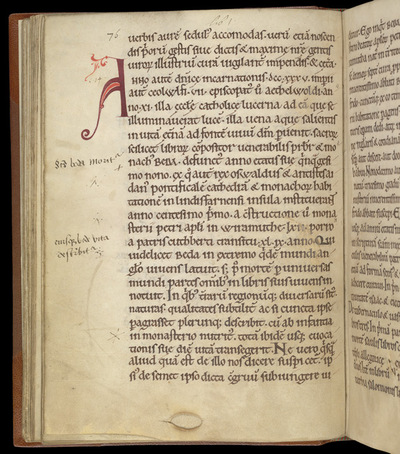Javascript must be enabled to continue!
Decorated Initial And The Death Of Bede, In Simeon Of Durham's 'History Of The Church Of Durham'
View through Europeana Collections
Simeon of Durham (c.1070-c.1130) was precentor of
the monastic cathedral of Durham. He based his 'History of Durham'
on the writings of Bede, an anonymous Northumbrian chronicler,
Florence of Worcester, and on his own knowledge. This manuscript
was apparently produced at Durham, as its artist decorated some
other Durham books. Fairly soon after, however, it was acquired by
Fountains Abbey, about 50 miles south in Yorkshire. This initial
'A' marks the start of a section beginning at the year AD 735.
Various readers have marked passages with marginal notes and
symbols, the first of which marks the mention of the death of 'the
Venerable' Bede.
Title: Decorated Initial And The Death Of Bede, In Simeon Of
Durham's 'History Of The Church Of Durham'
Description:
Simeon of Durham (c.
1070-c.
1130) was precentor of
the monastic cathedral of Durham.
He based his 'History of Durham'
on the writings of Bede, an anonymous Northumbrian chronicler,
Florence of Worcester, and on his own knowledge.
This manuscript
was apparently produced at Durham, as its artist decorated some
other Durham books.
Fairly soon after, however, it was acquired by
Fountains Abbey, about 50 miles south in Yorkshire.
This initial
'A' marks the start of a section beginning at the year AD 735.
Various readers have marked passages with marginal notes and
symbols, the first of which marks the mention of the death of 'the
Venerable' Bede.
Related Results
Decorated Initial And The Death Of Edward The Confessor, In
Simeon Of Durham's 'History Of The Church Of Durham'
Decorated Initial And The Death Of Edward The Confessor, In
Simeon Of Durham's 'History Of The Church Of Durham'
Simeon of Durham (c.1070-c.1130) was precentor of
the monastic cathedral of Durham. He based his 'History of Durham'
on the writings of Bede, an anonymous Northumbrian chronicler,
...
Decorated Initial, In Simeon Of Durham's 'History Of The
Church Of Durham'
Decorated Initial, In Simeon Of Durham's 'History Of The
Church Of Durham'
Simeon of Durham (c.1070-c.1130) was precentor of
the monastic cathedral of Durham. He based his 'History of Durham'
on the writings of Bede, an anonymous Northumbrian chronicler,
...
Decorated Initial And Ownership Inscription, In Simeon Of
Durham's 'History Of The Church Of Durham'
Decorated Initial And Ownership Inscription, In Simeon Of
Durham's 'History Of The Church Of Durham'
Simeon of Durham (c.1070-c.1130) was precentor of
the monastic cathedral of Durham. He based his 'History of Durham'
on the writings of Bede, an anonymous Northumbrian chronicler,
...
Breechcloth
Breechcloth
Breechcloth; probably Yanktonai; 1860-1870Wool, porcupine quills, sinew, metal, horsehair, pigments; 117.5 x 28.5 cm.\RMV 710-9; Herman F.C. ten Kate collection; purchased from tra...
Winch Bridge, Durham, in Hutchinsons Tour
Winch Bridge, Durham, in Hutchinsons Tour
View of the Winch Bridge across a rocky gorge
above the River Tees in County Durham. William Hutchinson,
antiquarian of Durham, wrote on the antiquaries or County Durham in
1785-17...
Cross in the Wilderness
Cross in the Wilderness
In the United States the dissemination of the writings of the German naturalist Alexander von Humboldt in the mid-nineteenth century aroused a growing interest in South America, to...
Hackney Church
Hackney Church
This view of Hackney Church was taken from Pig
Well, one of several nearby wells known for the purity of their
water.In medieval times, the church had been dedicated to St
Augustin...
Brisé fan of paste board covered with silk, decorated with straw appliqué work, probably made in Florence, 1620s. Brisé fan of seven sticks, each one shaped to represent a curled feather. Cut straw, applied to silk covered cardboard. The sticks are made o
Brisé fan of paste board covered with silk, decorated with straw appliqué work, probably made in Florence, 1620s. Brisé fan of seven sticks, each one shaped to represent a curled feather. Cut straw, applied to silk covered cardboard. The sticks are made o
Brisé fan of paste board covered with silk, decorated with straw appliqué work, probably made in Florence, 1620s. Brisé fan of seven sticks, each one shaped to represent a curled f...
Recent Results
Logical Form through Abstraction
Logical Form through Abstraction
Abstract
In a recent book, Logical Form: between Logic and Natural Language, Andrea Iacona argues that semantic form and logical form are distinct. The semantic form...
Abstraction
Abstraction
This text elaborates an understanding of abstraction as fundamental to how we think from a closer look at relationships between abstraction, movement, materiality and lived experie...
Antoni Gaudí
Antoni Gaudí
Antonietta Iolanda Lima, Criticism and interpretation, January 2002, Testo & Immagine...











 Your session has timed out for security reasons.
Your session has timed out for security reasons.